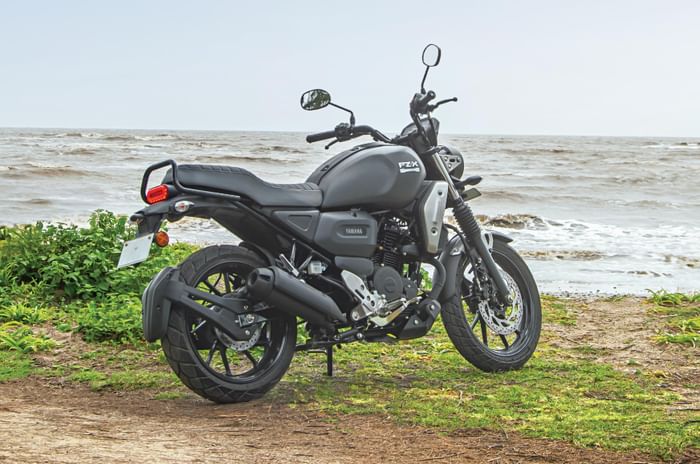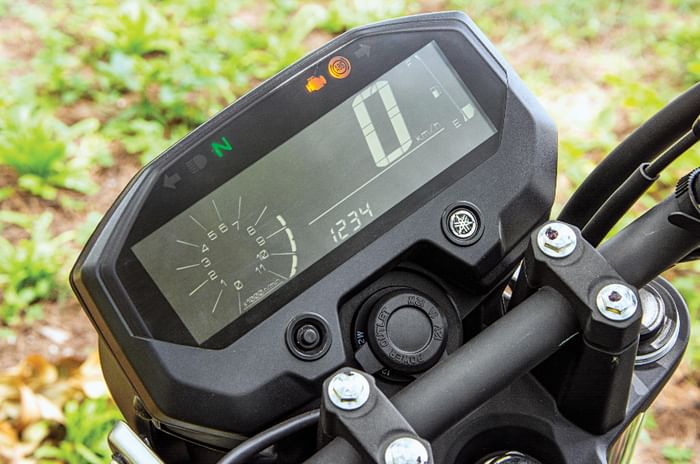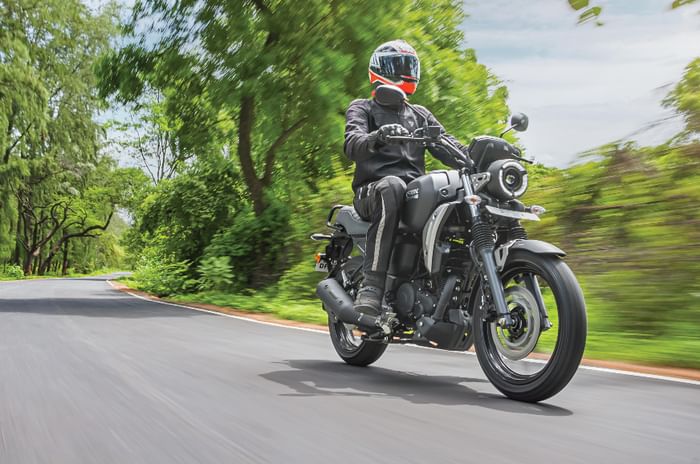In a market as unforgiving as ours, it must be quite the task for manufacturers to find the sweet spot between what their market surveys suggest and what the manufacturer thinks the market actually needs. Take Yamaha, for example – enthusiasts have been clamouring for the company to bring its lovely XSR 155 to India, ever since the bike was revealed two years ago. Yamaha has clearly heard all these people, but then it seems to have decided that instead of bringing the more expensive XSR (based on the R15 platform), it would make more sense to build a special bike for India, based on the simpler, cheaper and higher selling FZ. That’s how we’ve ended up with the FZ-X, a motorcycle that underneath the skin is pretty much identical to the standard FZ.
Yamaha FZ-X: design
Be that as it may, there’s plenty to talk about what lies on top, because the FZ-X looks remarkably different to the standard FZ, despite sharing the same underpinnings.
The face is characterised by a modern-looking round headlamp that houses a bi-functional LED bordered by three sleek position lights. The teardrop-shaped fuel tank is flanked by a pair of good-looking radiator shrouds, although these are purely cosmetic because this bike has no radiator.

Things get more simple towards the rear, with a long seat and a neat looking LED tail-lamp. The rear three-quarter proportions look rather awkward. While the cost benefit of using the FZ’s chassis were seemingly too tempting to resist, this design could have been much more cohesive if Yamaha had at least thrown in a new sub-frame.
What Yamaha has given the bike is a new LCD display. It looks quite nice and can also show some phone notification details via Bluetooth. If you pay Rs 3,000 extra for the top model, the FZ-X will be compatible with Yamaha’s new Y-connect Bluetooth app, which brings in features like fuel consumption, maintenance recommendations and much more. Unfortunately, this app still doesn’t support turn-by-turn navigation.

There are a few other issues as well, including the fact that the new display doesn’t have a gear position indicator. Then there’s that practical, but rather utilitarian grab rail, although this can be removed if you like. And finally, a hinged fuel filler cap would have been nice. On the plus side, the bike does get a conveniently located 12V power outlet. The FZ-X is available in two other colours, including a particularly striking shade of Blue.
Overall, the proportions look pretty much as awkward in person as they do in the images. The bike does look quite large, thanks to its wide new fuel tank, but it holds just 10 litres versus 13 in the standard FZ.
Yamaha FZ-X: how does it perform?
With its smaller fuel tank, the FZ-X is going to need more frequent fuel stops because it runs the same motor from the FZ, and that includes internal gearing as well as the chain sprocket sizes. What you get is a simple, air-cooled two-valve, 149cc engine with a smooth 5-speed gearbox. Power stands at a meek 12.4hp while peak torque is 13.3Nm. Both figures are not only the lowest in the segment by a considerable margin, but the power figure is just 0.4hp higher than the Bajaj Pulsar NS125, which we have also reviewed this month.

The Yamaha FZ’s steady decline in performance over the years is a pity. It comes as no surprise that this is not a bike you should be considering if you have even the slightest inclination for speed and excitement. Quick overtakes need a downshift or two, as well as twisting the throttle all the way open. Anything above 80kph feels like a struggle and the true top speed isn’t likely to be much above 100-110kph.
On the plus side, Yamaha has tuned the exhaust to produce a deeper and more peppy exhaust sound than the standard FZ. It’s a little reminiscent of the sound the Honda CB350 makes, but certainly not as loud or pronounced.
The FZ-X doesn’t have any significant top-end performance to talk about, and revving it above 8,000rpm is quite pointless. However, the motor is smooth and refined at normal running speeds and it packs a decently strong midrange that will make it a nice city bike.
Yamaha FZ-X: ride and handling
Yamaha is clearly going for the allure of comfort and practicality with the FZ-X. Compared with the FZ, the ergos are more relaxed, with a higher handlebar, more forward-set foot pegs, as well as a wider and more spacious seat. The seat height has gone up slightly, but at 810mm it should still be pretty approachable for a majority of riders.
The predominant experience on the road is that the FZ-X feels light and easy on its feet. At 139kg, it weighs 4kg more than the standard FZ, but that’s because components like the fuel tank, fake radiator shrouds, front mudguard, headlamp brackets and thin bash guard at the bottom are now all metal.

The actual handling itself is fine, with a balanced and neutral chassis, but it’s certainly not the sharpest or most exciting bike in the segment. The MRF dual-purpose tyres it runs on work fine on dry surfaces, but they don’t appreciate being pushed too hard.
Ride quality is decent, with a slightly firm feel from the suspension and while the front brake feels quite dull, the actual braking performance is adequate. A rear disc is standard and the FZ-X comes with single-channel ABS.
The FZ-X may be styled like a scrambler, but its actual off-road capability is pretty much identical to the standard FZ. That’s because the suspension travel and ground clearance remain the same and the only difference is the extra grip the tyres provide in the dirt.
Yamaha FZ-X: Should I buy one?
This is not a cheap bike by any means, and the Y-Connect Bluetooth-enabled model costs about Rs 12,000 more than the standard FZ-S FI. At this price, it’s more expensive than the premium 150-160cc bikes from Bajaj, Hero, Honda, Suzuki and TVS, and is positioned on par with the Hero Xpulse 200.
To sum up, the FZ-X is certainly a striking and unique motorcycle, and that’s pretty much the main reason to consider buying one. If you like the way it looks, you’ll be getting a tried and tested platform underneath, with a practical, yet eye-catching motorcycle on top. But if the design doesn’t do it for you, there are plenty of more convincing options out there.









































